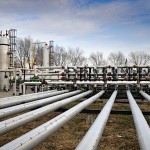WTI and Brent futures were steady during midday trade in Europe today. Crude contracts surged yesterday, as Iraq, a major oil producer and exporter, saw heavy and widespread fighting. Meanwhile, natural gas futures were lower, after a significant gain on smaller-than-expected US supplies injection on Thursday.
West Texas Intermediate futures for settlement in July traded for $106.65 per barrel at 13:46 GMT on the New York Mercantile Exchange, up 0.11%. Prices ranged from $106.37 to $107.68 per barrel, reaching a nine-month high. WTI August contracts added 2.04%, and so far this week the US benchmark has added 1.6%.
Meanwhile on the ICE in London, Brent futures due in August stood for a 0.06% gain at $112.49 per barrel at 13:46 GMT. Daily high and low stood at $114.07 and $112.16 per barrel, respectively, reaching a nine-month high. Brent’s premium to August WTI stood at $6.56, after Thursday’s closing margin of $6.64. Brent’s August contract added 2.79% yesterday, and so far this week the European brand has gained more than 4%.
Iraq
Iraq was the scene of a bloody religious onslaught over the last couple of days, when a Sunni Islamist organization, boasting some 5 000 troops, according to the BBC, launched assaults on towns in the northern provinces of the country. The group, called ISIS, or ISIL, is linked with al-Qaeda, and is composed of Sunni extremists, who regard Shia Muslims, who represents the majority of the population in Iraq and Iran, as infidels.
Developments shook markets, as the US said they are “considering all options, including military”. Earlier, the Iraqi oil minister had said that the US would provide air support for Iraqi ground troops retaliating against the insurgents.
Meanwhile, the Shia majority have been urged by clerics to take up arms, in response to the Sunni onslaught, which reportedly left hundreds dead.
Iraq is the second-largest OPEC oil producer, and shipped 5.43 million barrels from Basra on Wednesday alone, according to the oil minister.
US outlook
PPI for May was at -0.2% on a monthly basis, after 0.6% growth in April, while core PPI was at -0.1%, a report revealed today. The PPI standings follow the not-so-good figures from the US recently, after retail sales and jobless claims scored slightly worse than expected yesterday, though still recorded an expansion.
Previously, the US Energy Information Administration (EIA) posted its weekly oil inventories report for the seven day through June 6 on Thursday. The log revealed a 2.6-million-barrel drop for crude oil inventories, with a sizable decline for imports, which have now dropped almost almost 20% over the last two weeks. Meanwhile, gasoline stockpiles added 1.7M barrels, while distillates gained 0.9 million. The report also revealed sizable drops for distillates and gasoline production, with a downturn in the refinery utilization rate.
Elsewhere, China, which accounts for 11% of total oil demand, posted key data earlier today. Industrial production for May was logged at 8.8% annual growth, in line with expectations, after 8.7% in April. The industrial sector accounts for nearly half of Chinese GDP. Fixed assets investments for May added on forecasts for an annual growth of 17.2%. Retail sales for May in China also improved on expectations and on the previous reading to record an yearly growth of 12.5%, after 11.9% in April.
Natural gas
Front month natural gas futures, due in July, dropped 0.59% at the New York Mercantile Exchange to trade for $4.734 per million British thermal units at 13:48 GMT. Prices ranged from $4.724 to $4.793 per mBtu, reaching a monthly high. Yesterday the contract added 5.63%, the biggest daily gain in four months, and so far this week natural gas futures have gained about 1.5%.
“Natural gas traders are prone to stampede; this is a very one-directional trade so there were not a lot of people selling into this rally to slow it down,” Tim Evans, energy analyst at Citi Futures in New York, said for Bloomberg. “We’ve had eight consecutive weeks with storage injections above the five-year average and the only bullish argument over this eight-week span is that it’s still not enough.”
The EIA posted its report on US natural gas inventories for the week through June 6 yesterday. The log revealed stockpiles had added 107 billion cubic feet (bcf). A Bloomberg survey had suggested a 109-bcf gain.
Previously, last week’s log revealed a gain of 119 billion cubic feet (bcf), beating expectations of a 116-bcf increase. The injection was the biggest stockpiles had received since June 2009. However, inventory levels remain 31% below readings from last year, but gradually recover.
The EIA raised its inventories levels forecast through November, when heating demand usually picks up, to 3.424 trillion cubic feet, which would be more then enough to cover a harsh winter.





